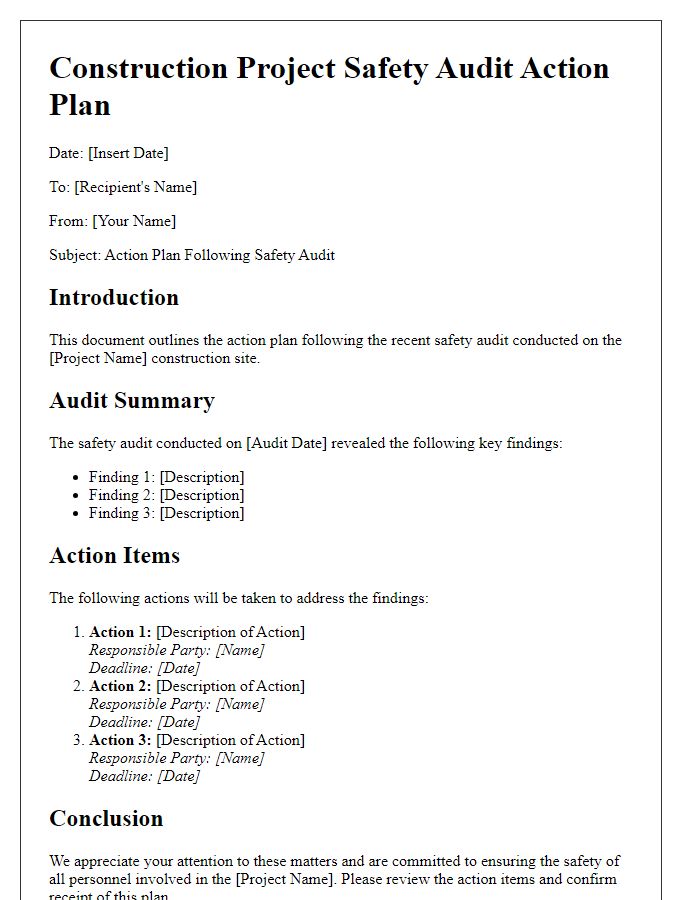Ensuring safety on a construction site is not just a regulatory requirement; it's a fundamental obligation we have towards our team and the community. In this article, we'll explore the essential components of a construction project safety audit, highlighting best practices and strategies to maintain a secure work environment. From identifying potential hazards to assessing compliance with safety standards, we've got you covered. So, let's dive in and discover how we can enhance safety measures on our projects!

Project Identification and Scope
Project identification encompasses essential details regarding the construction undertaking. It includes the project's title, a unique project identification number assigned for tracking purposes, client name, and contact information (phone number, email). The scope of the project outlines specific construction activities, such as site preparation, foundation work, structural framing, and installation of mechanical systems. Geographic location plays a vital role, detailing the site address, proximity to emergency services, and potential environmental hazards present, like nearby water bodies or wildlife. Compliance requirements must be highlighted, including local safety regulations, environmental guidelines, and industry standards applicable to construction practices. Contingency planning for safety audits should also specify potential risks, employee training programs, and emergency response strategies to ensure worker safety throughout the construction process.
Audit Objectives and Criteria
A construction project safety audit aims to evaluate compliance with safety regulations and identify potential hazards to ensure worker safety. The primary objectives include assessing adherence to Occupational Safety and Health Administration (OSHA) standards, reviewing safety training programs for laborers and supervisory staff, and inspecting personal protective equipment (PPE) usage on-site. Criteria for evaluation consist of incident reporting mechanisms, safety committee effectiveness, first aid accessibility, and emergency evacuation procedures. Other essential aspects include an analysis of the safety culture among workers, documentation of safety meetings, and inspection records for equipment maintenance, particularly for high-risk machinery such as cranes and excavators. Ensuring comprehensive compliance with these objectives and criteria enhances overall site safety and minimizes the risk of accidents, injuries, and legal liabilities.
Safety Standards and Regulations Compliance
A comprehensive construction project safety audit assesses compliance with safety standards and regulations, ensuring adherence to guidelines established by organizations such as OSHA (Occupational Safety and Health Administration). Key focus areas include proper use of personal protective equipment (PPE), like hard hats (ATG 10-rated for impact protection) and safety goggles (ANSI Z87.1), along with site-specific safety protocols. Additionally, inspection of scaffolding (meeting the American National Standards Institute regulations) and fall protection systems (such as guardrails and harnesses) is critical for worker safety. Fire safety measures, including access to extinguishers (Class A, B, C ratings as per NFPA guidelines), should also be evaluated. The audit serves to mitigate risks associated with job site hazards, thereby promoting a culture of safety among construction workers and management.
Inspection Schedule and Procedure
A construction project safety audit focuses on maintaining stringent safety standards to protect workers and ensure compliance with regulations. The provided inspection schedule outlines crucial dates for safety checks, targeting specific areas such as scaffolding, fall protection systems, and personal protective equipment (PPE) usage. Each inspection will be documented meticulously, detailing observations and identifying potential hazards present on-site, such as electrical safety risks or the presence of hazardous materials. Additionally, personnel will be trained on emergency response procedures, ensuring immediate action can be taken in the event of an incident. Records from past audits (dated monthly from January to October 2023) will serve as benchmarks for improvement and reinforce the importance of sustained safety measures throughout the duration of the project at the construction site, located in downtown Los Angeles, California.
Reporting and Feedback Mechanisms
Construction project safety audits are crucial for maintaining workplace safety standards, particularly in high-risk environments like construction sites. Regular inspections can identify potential hazards, including equipment malfunctions and worker safety compliance issues. Detailed feedback mechanisms, such as weekly reports and safety meetings, ensure that all team members receive updates on safety protocols and incident reports. Utilizing software tools for real-time reporting can enhance communication regarding safety observations. Additionally, incident tracking systems can document near-misses, providing valuable data for improving safety measures. Effective training programs, such as those mandated by OSHA (Occupational Safety and Health Administration), empower workers with the knowledge to recognize and mitigate risks, creating a proactive approach to safety on construction sites.













Comments